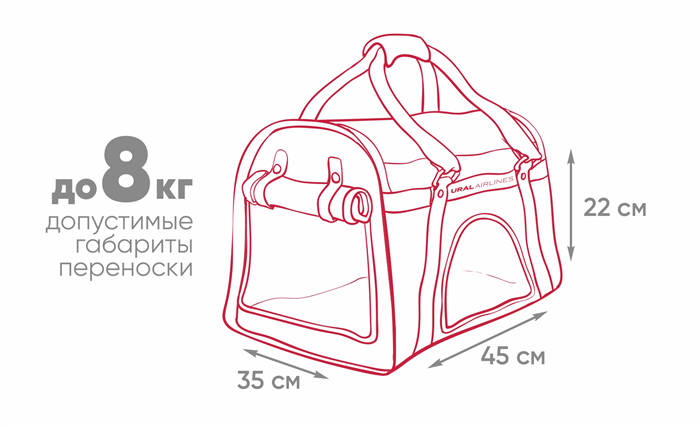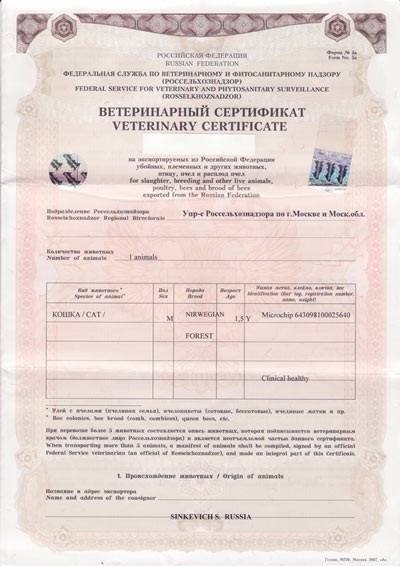There are a number of preflight formalities and requirements related to border, customs, sanitary-quarantine, veterinary, phytosanitary quarantine control, stipulated by the legislation of the Russian Federation, which a passenger must fulfill at the airport of transfer for further transportation on the route, as well as the requirements of state authorities at transfer points in international transportation. You can familiarise yourself with these requirements on the web-sites of the official agencies, and also on the official web-site of the airline-carrier.

Animals
The cost is indicated for the whole route in a one-way ticket irrespective of the number of segments.
Fee for cancellation of previously ordered transportation of pets or birds in the cabin is 25% of service cost.
8 800 7700 262 (Free of charge within Russia)
+7 (499) 920 22 52 (For calls from abroad)
+99 655 04 00 00 5 (For Kyrgyz passengers)
+992 77 777 08082 (For passengers from Tajikistan)
Animals in cages/carriers accompanied by an adult passenger of full legal capacity are allowed in the cabin. The kennel/carrier may contain several animals or birds of the same species. The caged animals or birds must be loose and comfortable for the pets. If the carrier is made of thick textile (is soft), the size of the cage / carrier should not exceed the parameters 45x35x25 cm. If the carrier/cage has a hard frame, the maximum size is 45x35x22 cm. Total weight together with the cage up to 8 kg.
Please note that on the flight from/to China the passenger may take on board only one crate/carrier which size shall not exceed the following dimensions: 45x35x25cm. Only one animal or bird may stay in the cage/carrier.
Check-in for flights with pets takes place only at the check-in counters at the airport. We recommend arriving at the airport well in advance to register your pet for the flight.
*Only cats or dogs are accepted for transportation with a ticket for "Business" class.
It is forbidden to take pets out of the container / cage in the passenger cabin and feed them during the flight.
In case of exceeding the fixed dimensions, pets must be transported as hand baggage with the provision of an additional passenger seat in the cabin, subject to the purchase of the 'Cabin Baggage' service. Charging according to the cost of the air ticket for the chosen direction.
In Russia and the CIS countries
The veterinary certificate (Form No.1) which is issued 3 days before the trip and is valid during this period is usually sufficient for travelling with pets within Russia. The certificate contains the owner's name and the route of the trip, information about the animal, its vaccinations and tests.
To obtain a certificate, go to any state veterinary service with your pet and its veterinary passport.
Prior to check-in, pets must be inspected at the airport. For this purpose, you need a veterinary passport and a certificate (form No.1). After checking documents, the certificate is stamped, allowing you to travel, which you show at the check-in desk. An employee of the airport weighs the animal and directs the passenger to pay at the ticket office. Only after all these procedures, the passenger is given a boarding pass.
Learn more about how to carry a dog on the plane on the website of the airline you are flying with or from the support service of Tutu.ru. For this service, please leave a request more than 72 hours before departure, which should include the total weight of the animal with the cage, the size of the cage length*width*height, the breed of the animal:
-by phone 7 499 715 41 05 (be ready to tell the number of reservation, order or the phone number indicated at registration in the order);
-by sending an e-mail to info@tutu.ru or avia@tutu.ru, indicating the reservation, order or telephone number given at the time of reservation.
The airline will take 24 hours to reply. We will inform you whether the service is confirmed or denied.
Find out whether the airline allows you to transport pets before you buy your ticket.
When traveling on long-haul trips
To transport a dog, cat, or feathered animal abroad by air, it is necessary to prepare in advance and collect a huge number of documents. The animal must undergo examinations and inspections, undergo tests and be vaccinated.
In addition, many countries impose special rules for the import of animals. For example, some European countries prohibit the importation of fighting dogs. Island countries often prohibit the importation of animals altogether (Malta, United Kingdom), or place them in quarantine. To avoid trouble, find out in advance about the laws of the country you are traveling to.
How to prepare your pet for a flight

At home. Before you leave for the airport, lay absorbent diapers on the bottom of the carrier – you can buy them at any drugstore, pet store or supermarket. Check all fasteners and lock or remove wheels, if any. Donate your pet's blanket or scarf, or put his bedding in the container, along with his favorite toy, so you can simulate a familiar environment. Ask for a sticker at the check-in desk, write Live Animal on it, draw two arrows and stick it on the carrier so that the movers handle the container carefully and know which side up it should be. Cats and dogs should not drink or eat anything five to six hours before departure. Careful with sedatives: the body's reaction to tranquilizers in flight conditions is unpredictable. Never give sleeping pills: at altitude they may cause problems with blood circulation and pressure. For tranquilizers and sleeping pills consult your veterinarian. At the airport. If it is a long flight, and the animal travels in the luggage, already at the airport after check-in fill it up with food and water. If your pet travels with you in the cabin, stock up on water, too: dehydration happens faster during the flight. Arrive at the airport three to five hours before departure. At the 24-hour veterinary inspection point, exchange the veterinary certificate No. 1 for an international certificate Form 5A. It is valid for exactly one day. Check all the data on the certificate and make sure that you have been stamped. Make an appointment in advance so that the necessary papers are ready when you arrive. You may find the telephone numbers of veterinary offices at Moscow airports on the web-site of Rosselkhoznadzor. If your pet is flying in a separate compartment, weigh it in the carrier at the oversized luggage check-in counter. Usually each kilogram is paid as 1-2 kilograms overweight plus a set fee. Pay for your pet's ticket (from 2500 P), get your boarding pass and go to the check-in with or without your pet. If a pet travels in the cabin you can't check-in with an animal via Internet, but you must pay for the pet's seat even if you're not travelling with other baggage. If you fly with long connections and your pet travels in luggage, you will have to pay extra for the service during the connection. The price depends on the airline and airport. At Amsterdam Airport Schiphol on KLM flights, this service costs $200 ($18,743).
Р ).
A few more rules for transporting your pet
Taking a dog out. According to the rules for exporting a dog you need a certificate of no pedigree value, which is issued by the Russian Cynology Federation (RKF). Usually nobody asks for this certificate, but it's better to make it. Come to the RKF during its working hours, fill out the form, pay the fee of 500 R – and the certificate is yours. Large dog. Pets weighing over 40-50 kg should fly only in the cargo hold with a bill of lading. Call the airline. A rare venomous snake. Call the airline and find out if they take them and under what conditions. You will need permission from the State Committee of the Russian Federation for Environmental Protection. The animal does not travel abroad. When traveling in Russia, it is the same, only without an international certificate and with fewer vaccinations – one rabies vaccine is enough.
The animal is afraid to fly. Use the train. Small cats, dogs and birds can travel in all carriages, except SV, with a veterinary certificate and passport. To transport large dogs you will need to buy a whole compartment, even if you are traveling with two of them.






